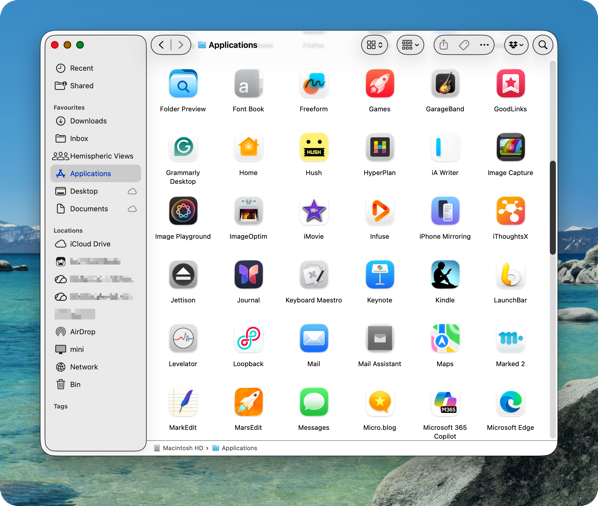2025-12-10 11:46:47
I couldn’t take anymore Tahoe Liquid Glass shenanigans. So I’m back to this classic look.
At least I have my proxy icons back.

2025-12-01 22:35:24
It has been more than 2 years (😱) since Episode 097 of my podcast Hemispheric Views, where we held a Duel of the Defaults! competition.
Two years on, where do I stand now?
If there is a change from my list last year, I’ve indicated it with a leading ✨.
| Change? | Category | Default | Comment on Change |
|---|---|---|---|
| ✨ | Mail Client | Fastmail | Goodbye Fmail3 |
| Mail Server | Fastmail & Apple Mail | iCloud is there, but I don’t actively use it | |
| Notes | Obsidian for Work; Apple Notes for Home | ||
| To-Do | OmniFocus | ||
| iPhone Photo Shooting | Camera.app | ||
| Photo Management | Photos.app | ||
| Calendar | BusyCal (plus Calendar.app) | ||
| Cloud file storage | iCloud (plus OneDrive) | ||
| RSS | Reeder with FreshRSS | ||
| Contacts | Contacts.app | ||
| ✨ | Browser | Safari | Despite trying Vivaldi and Firefox, I always come back to Safari |
| Chat | Signal | ||
| Bookmarks | Safari | Goodlinks is gone; back to basics | |
| Read It Later | GoodLinks | Rarely used now; very few worthwhile things to read (later) on the web | |
| Word Processing | n/a | I don’t process words | |
| Spreadsheets | Numbers (plus Excel) | ||
| Presentations | n/a | I don’t do presentations | |
| Shopping Lists | AnyList | ||
| Meal Planning | AnyList | ||
| Budgeting & Personal Finance | Actual Budget on PikaPods | ||
| ✨ | News | RSS & NYTimes | |
| Music | Apple Music | ||
| ✨ | Podcasts | Castro | I got bored with PocketCasts |
Four changes this year from 23 categories. 8 of the 23 are true defaults.
2025-11-17 22:30:12
For about the 14th time in my life I am once again experimenting with David Seah’s Emergent Task Planner sheets.
2025-11-14 17:59:26
It’s Hemispheric Views episode 150 Or is it 152? Or 153? Who knows, but it’s here! We’ve got mail and Martin has coffee! Pay attention, there is homework for you in this one.